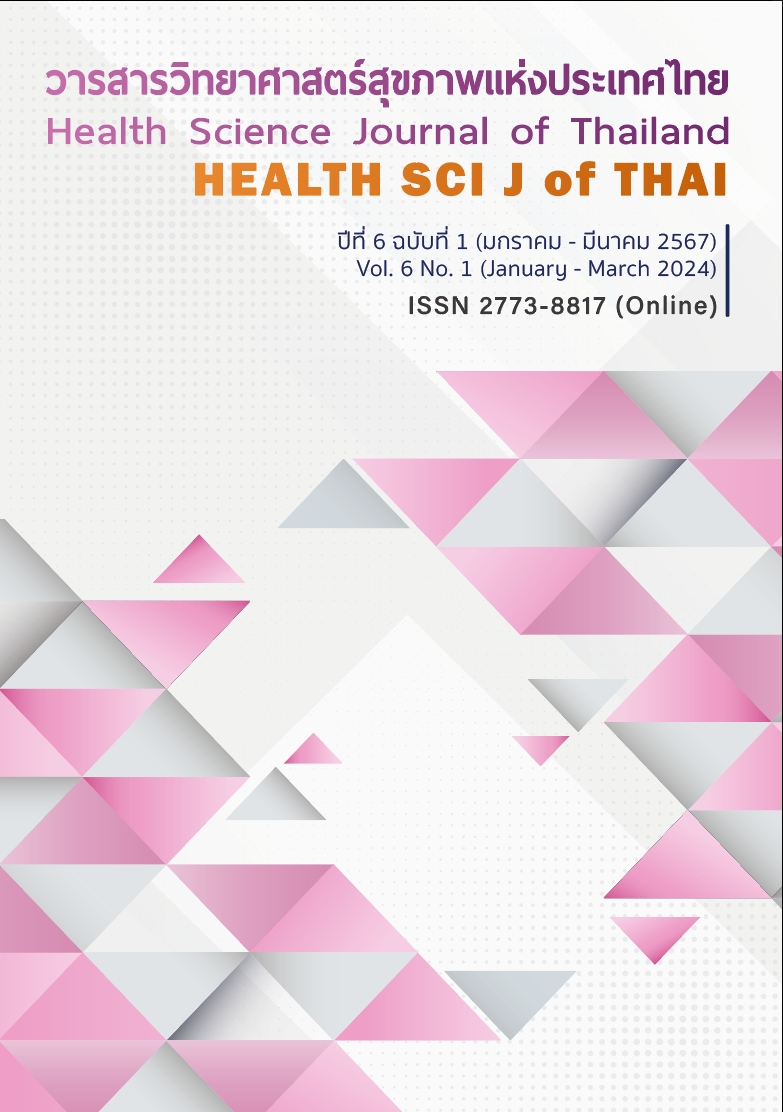Prevalence and Related Factors of Incontinence Associated Dermatitis (IAD) in Normal Care in the Neonatal Intensive Care Unit
Main Article Content
Abstract
The study of prevalence and the related factor of Incontinence Associated Dermatitis (IAD) from 135 neonatal intensive care unit patients using the Neonatal Tissue Viability Risk Assessment Tool; NTV. The study found the IAD in 6 cases (4.40%). The severity was divided into Category 1 and Category 2 there are 3 cases per level. The area of IAD such as around the anus 6 cases (100%). The relationship between the factors was the gestational age of less than 32 weeks (p-value = 0.002), Birth weight ≤ 1,500 grams (p-value = 0.003), Length of stay in NICU of more than 20 days (p-value =0.003), and NTV points ≥ 20 (p-value = 0.002) It has a relationship with the complications of IAD by uncontrolled excretion. Skin assessments in the neonatal intensive care unit are important. Therefore, the healthcare team should make an important about caring for and treating critical illness.
Article Details

This work is licensed under a Creative Commons Attribution-NonCommercial-NoDerivatives 4.0 International License.
References
McNichol LL, AyelloEA, Phearman LA, Pezzella PA, Culver EA. Incontinence-associated dermatitis: State of the science and knowledge translation. Adv Skin Wound Care 2018; 31(11): 502-13.
Millard N. Moisture lesions and incontinence associated dermatitis. NHS. Brighton and Sussex University Hospital Publishing; 2019.
Uppanisakorn S, Sommai T, Vattanaprasan P, Boonyarat J. Prevention and treatment of incontinence-associated dermatitis (IAD) in critical patients treated in the intensive care unit of a medical ward. Thai J Nurs 2015; 30(2): 86-100.
Kongpet J, Wattanasit P, Wiroonpanich W. Effects of a skin care program on incidence and the level of severity of diaper dermatitis in children with diarrhea. Songkla Med J 2015; 33(1): 41-52.
Noonan C, Quigley S, Curley MAQ. Skin integrity in hospitalized infants and children a prevalence study. J Pediatr Nurs 2006; 21(6): 445-53
Adalat S, Wall D, Goodyear H. Diaper dermatitis-frequency and contributory factors in hospital attending children. Pediatr Dermatol 2007; 24(5): 483-88.
Li CH, Zhu ZH, Dai YH. Diaper dermatitis: a survey of risk factors for children aged 1-24 months in China. Int J Med Res 2012; 40: 1752-60.
Sukhneewat C, Chaiyarit J, Techasatian L. Diaper dermatitis: a survey of risk factors in Thai children aged under 24 months. BMC Dermatol 2019; 19(7): 1-6.
Visscher MO, Adam R, Brink S, Odio M, Visscher MO, Adam R, et al. Newborn infant skin: Physiology, development, and care. Clin Dermatol 2015; 33: 271–280.
Kaewkab U, Chanruangvanich W, ThosinghaSuporn O, Danaidutsadeekul S. The effects of utilizing clinical nursing practice guidelines for prevention of perineal dermatitis in neurological patients with urinary incontinence. J Nurs Sci 2011; 29(4): 37-45. (in Thai)
Krejcie VR, Morgan WD. Determining sample size for research activity. Educ Psychol Meas 1970; 30: 607-10.
Jani P, Mishra U, Buchmayer J, Maheshwari R, D’Cruz D, Walker K, et al. Global variation in skin injures and skincare practice in extremely preterm infants. World J Clin Pediatr 2022: 1-19.
Johnson DE. Extremely preterm infant skin care. A transformation of practice aimed to prevent harm. Adv Neonatal Care 2016; 16(5S): S26-32.
Lund C, Medical Adhesives in the NICU. Newborn Infant Nurs Rev 2014; 14: 160-65.
Gray M, Giuliano KK. Incontinence-associated dermatitis, characteristics and relationship to pressure injury: a multisite epidemiologic analysis. J Wound Ostomy Cont Nurs 2018; 45(1): 63–7.
Kaplan HC, Lannon C, Walsh MC, Donovan E F. Ohio statewide quality-improvement collaborative to reduce late-onset sepsis in preterm infants. Pediatrics 2011; 127(3): 427-35.
Ashworth C, Briggs L. Design and implementation of a Neonatal Tissue Viability Assessment Tool on the newborn intensive care unit. Infant 2011; 7(6): 191-4.
Broom M, Dunk AM, Mohamed ALE. Predicting neonatal skin injury: the first step to reducing skin injuries in neonates. Health Serv Insights 2019; 12: 1178632919845630.
Zhang H, Ma Y, Wang Q, Zhang X, Han L. Incidence and prevalence of pressure injuries in children patients: A systematic review and meta-analysis. J Tissue Viability 2022; 31(1): 142-51.
Gray M, Giuliano KK. Incontinence-associated dermatitis, characteristics and relationship to pressure injury: a multisite epidemiologic analysis. J Wound Ostomy Cont Nurs 2018; 45(1): 63–7.


